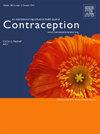高收入国家妇女堕胎特征的趋势
IF 2.3
2区 医学
Q1 OBSTETRICS & GYNECOLOGY
引用次数: 0
摘要
我们将在2000年至2023年期间,根据堕胎法宽松的高收入和中等收入国家15-49岁妇女的年龄组、工会状况、胎龄、堕胎方式、胎次和出生情况,估计堕胎发生率的水平和趋势,包括美国,其中一些州的堕胎法宽松。方法计算特征百分比分布和流产率。我们收集了来自所有高收入和中等收入国家的堕胎数据,并根据任何其他感兴趣的特征收集了有关堕胎的可靠、公开的信息。对于没有公开信息的国家,我们通过向能够获得这些国家堕胎统计数据的专家发送问卷的方式收集数据。迄今为止,我们已经收集了来自32个国家的数据。人口估计将从联合国世界人口展望中得出。我们将确定各国特定特征率的共同模式,并突出显示偏离这些模式的国家和自2000年以来经历了最重大变化的国家。我们还将研究哪些亚组在堕胎发生率方面发生了最实质性的变化,从而潜在地确定堕胎发生率变化的主要决定因素。结论:我们将在有关政策、避孕药具使用和社会规范等决定因素的文献背景下,讨论所观察到的跨国堕胎发生率差异和趋势的潜在解释。这一分析将有助于进一步了解高收入和中等收入国家的堕胎动态。此外,这些调查结果将有助于为公共卫生战略提供信息,并有助于公众了解这些国家人口的生殖健康需求。本文章由计算机程序翻译,如有差异,请以英文原文为准。
TRENDS IN THE CHARACTERISTICS OF WOMEN OBTAINING ABORTIONS IN HIGH-INCOME COUNTRIES
Objectives
We will estimate levels and trends in abortion incidence by age group, union status, gestational age, method of abortion, parity, and nativity for women aged 15-49 in high- and middle-income countries with liberal abortion laws — including the US, where liberal laws prevail in some states — between 2000 and 2023.
Methods
We will calculate characteristic-specific percentage distributions and abortion rates. We compiled abortion data from all high- and middle-income countries with reliable, publicly available information on abortion by any of the other characteristics of interest. For countries without publicly available information, we collected data through a questionnaire sent to experts with access to abortion statistics in those countries. To date, we have gathered data from 32 countries. Population estimates will be drawn from the UN World Population Prospects.
Results
We will identify common patterns in characteristic-specific rates across countries, and highlight countries that deviate from these patterns and those that have experienced the most substantial changes since 2000. We will also examine which sub-groups have seen the most substantial shifts in abortion incidence, potentially identifying leading determinants of change in abortion incidence.
Conclusions
We will discuss potential explanations for observed cross-country differences and trends over time in abortion incidence, in the context of the literature on their determinants, such as policies, contraceptive use, and social norms. This analysis will contribute to further understanding abortion dynamics in high- and middle-income countries. Additionally, these findings will help inform public health strategies and the public understanding of the reproductive health needs of the populations within these countries.
求助全文
通过发布文献求助,成功后即可免费获取论文全文。
去求助
来源期刊

Contraception
医学-妇产科学
CiteScore
4.70
自引率
17.20%
发文量
211
审稿时长
69 days
期刊介绍:
Contraception has an open access mirror journal Contraception: X, sharing the same aims and scope, editorial team, submission system and rigorous peer review.
The journal Contraception wishes to advance reproductive health through the rapid publication of the best and most interesting new scholarship regarding contraception and related fields such as abortion. The journal welcomes manuscripts from investigators working in the laboratory, clinical and social sciences, as well as public health and health professions education.
 求助内容:
求助内容: 应助结果提醒方式:
应助结果提醒方式:


